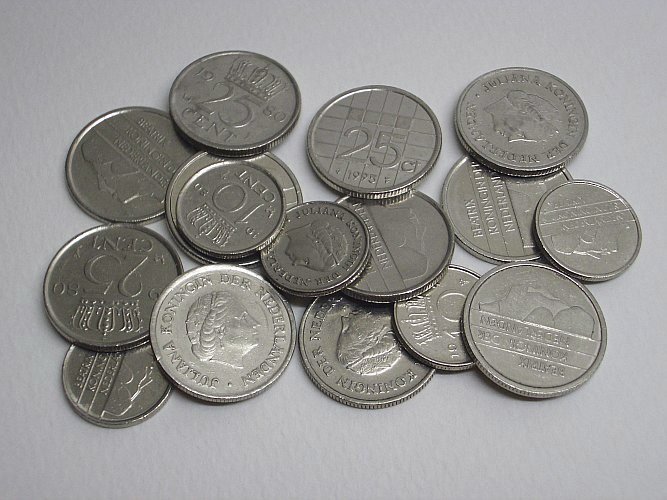


Nickel
 Elementary nickel is a metal with a lustrous silvery
tinge. It is attacked slowly by hydrochloric acid and dilute sulphuric acid,
forming divalent nickel
compounds. Nickel is attacked more rapidly by dilute to moderately concentrated
nitric acid. Concentrated nitric acid renders it passive.
Elementary nickel is a metal with a lustrous silvery
tinge. It is attacked slowly by hydrochloric acid and dilute sulphuric acid,
forming divalent nickel
compounds. Nickel is attacked more rapidly by dilute to moderately concentrated
nitric acid. Concentrated nitric acid renders it passive.
Nickel is the main constituent of many coins. The Dutch coins, used till 2002, for 10 cents, 25 cents, 1 guilder and 2½ guilders are made of 99.5% nickel. These coins can be used as a source for nickel salts, by dissolving them in 30% - 40% nitric acid.
Nickel metal of high purity also is available for reasonable price from vendors on eBay, which sell items for element collections. A more convenient option, however, is to purchase cheaply available compounds of nickel.
![]()
In aqueous chemistry, nickel is restricted to its +2 oxidation state. In the solid state, nickel compounds also can have oxidation states +3 and +4. Nickel compounds in oxidation state +2 are green/cyan.
The following nickel compounds are available for the general public at low prices:
- (basic) nickel carbonate, NiCO3·n Ni(OH)2 (0 ≤ n ≤ 2)
- nickel sulfate, NiSO4·6H2O
- nickel (III) oxide, Ni2O3
![]() Nickel carbonate or basic nickel carbonate is available from ceramics and pottery suppliers as a light
green fine powder, which easily dissolves in
dilute acids on slight heating. These solutions are green. Nickel carbonate is a convenient source of
nickel (II) solutions in combination
with any anion, depending on the acid in which it is dissolved. Nickel carbonate
also is cheap, hence, it is an interesting compound for the home lab. The
compound, available from ceramics suppliers is of variable composition. Whether
it is a carbonate, or contains quite some hydroxide is not very clear. However,
for practical purposes, this is of no real concern.
Nickel carbonate or basic nickel carbonate is available from ceramics and pottery suppliers as a light
green fine powder, which easily dissolves in
dilute acids on slight heating. These solutions are green. Nickel carbonate is a convenient source of
nickel (II) solutions in combination
with any anion, depending on the acid in which it is dissolved. Nickel carbonate
also is cheap, hence, it is an interesting compound for the home lab. The
compound, available from ceramics suppliers is of variable composition. Whether
it is a carbonate, or contains quite some hydroxide is not very clear. However,
for practical purposes, this is of no real concern.
![]() Nickel sulfate is a bright green/blue crystalline solid, which dissolves in
water easily, forming green solutions. For experiments with divalent nickel, this
compound even is more convenient than nickel carbonate. Preparing a neutral
solution of a nickel (II) compound, together with a non-coordinating anion, is
really easy, when this compound is available. So, when one wants to study the
properties of aqueous nickel in more detail, this is the compound to start with.
Nickel sulfate also is a cheap compound. It is available from chemical supply
houses and from certain hobby supply houses.
Nickel sulfate is a bright green/blue crystalline solid, which dissolves in
water easily, forming green solutions. For experiments with divalent nickel, this
compound even is more convenient than nickel carbonate. Preparing a neutral
solution of a nickel (II) compound, together with a non-coordinating anion, is
really easy, when this compound is available. So, when one wants to study the
properties of aqueous nickel in more detail, this is the compound to start with.
Nickel sulfate also is a cheap compound. It is available from chemical supply
houses and from certain hobby supply houses.
![]() Nickel (III) oxide is available from ceramics and pottery suppliers as a fine black powder.
This powder can be dissolved without much trouble in some dilute sulphuric acid,
by gently boiling the liquid for a while. When the oxide dissolves, it looses
oxygen and the solution formed from the oxide and the acid is a green solution,
containing nickel (II) ions. If nickel sulfate or nickel carbonate are not
available, then this is a reasonable alternative.
Nickel (III) oxide is available from ceramics and pottery suppliers as a fine black powder.
This powder can be dissolved without much trouble in some dilute sulphuric acid,
by gently boiling the liquid for a while. When the oxide dissolves, it looses
oxygen and the solution formed from the oxide and the acid is a green solution,
containing nickel (II) ions. If nickel sulfate or nickel carbonate are not
available, then this is a reasonable alternative.

![]() Nickel compounds
are carcinogens. The metal can be used safely, but the salts and solutions of
nickel compounds must be used with much more care.
Nickel compounds
are carcinogens. The metal can be used safely, but the salts and solutions of
nickel compounds must be used with much more care.